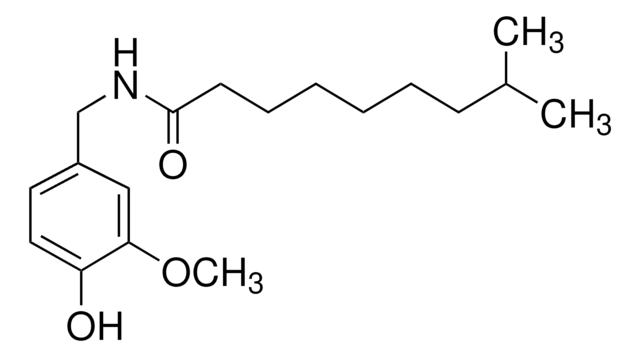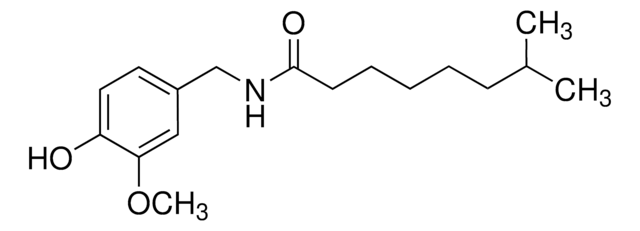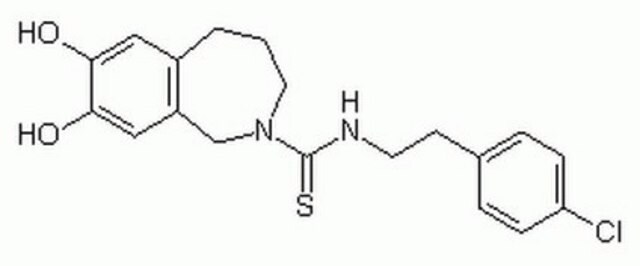推荐产品
product name
辣椒素, ≥95%, from Capsicum sp.
生物源
Capsicum sp.
品質等級
化驗
≥95%
mp
62-65 °C (lit.)
溶解度
H2O: insoluble
ethanol: soluble
儲存溫度
2-8°C
SMILES 字串
COc1cc(CNC(=O)CCCC\C=C\C(C)C)ccc1O
InChI
1S/C18H27NO3/c1-14(2)8-6-4-5-7-9-18(21)19-13-15-10-11-16(20)17(12-15)22-3/h6,8,10-12,14,20H,4-5,7,9,13H2,1-3H3,(H,19,21)/b8-6+
InChI 密鑰
YKPUWZUDDOIDPM-SOFGYWHQSA-N
基因資訊
human ... CYP1A2(1544) , TRPV1(7442)
rat ... Trpv1(83810) , Trpv4(66026)
正在寻找类似产品? 访问 产品对比指南
一般說明
Capsaicin is an alkaloid that is present inthe fruit of the Capsicum genus and is the main reason for the spicy flavor inhot peppers including jalapenos, habaneros, and red chili peppers. It isobserved that capsaicin acts as a chemoprotective agent and can induceapoptosis, inhibit proliferation, and induce cell-cycle arrest in variouscancer cells. Capsaicin activates its receptor transient receptorpotential vanilloid subfamily member 1 (TRPV1) and activates sensory afferentneurons that causes neurogenicinflammation, hypothermia, and pain.
應用
辣椒素已被用于:
- 研究其对与突触可塑性相关的染色质重塑和基因表达的影响
- 研究H2C1细胞(表达TRPV1通道的人胚肾293细胞)中的TRPV1通道信号
Capsaicin has also been used asa TRPV1 agonist to study the effect of barbamide on capsaicin response indorsal root ganglion sensory neurons.
生化/生理作用
原型香草受体激动剂。 神经毒素;激活产生无髓C纤维的感觉神经元,其中许多含有P物质。 局部使用可使感觉神经末梢脱敏,从而产生反常的抗伤害感受作用;全身给药可对辣椒素敏感的细胞产生神经毒性,尤其是在新生动物中。辣椒的活性成分。
訊號詞
Danger
危險分類
Acute Tox. 2 Oral - Eye Dam. 1 - Resp. Sens. 1 - Skin Irrit. 2 - Skin Sens. 1 - STOT SE 3
標靶器官
Respiratory system
儲存類別代碼
6.1A - Combustible acute toxic Cat. 1 and 2 / very toxic hazardous materials
水污染物質分類(WGK)
WGK 3
閃點(°F)
235.4 °F - closed cup
閃點(°C)
113 °C - closed cup
個人防護裝備
Eyeshields, Faceshields, Gloves, type P2 (EN 143) respirator cartridges
其他客户在看
Stimulation of TRPV1 channels activates the AP-1 transcription factor.
Backes TM, et al.
Biochemical Pharmacology, 150(3), 160-169 (2018)
Capsaicin upregulates HDAC2 via TRPV1 and impairs neuronal maturation in mice.
Wang S, et al.
Experimental & Molecular Medicine, 50(3), e455-e455 (2018)
Amol M Patwardhan et al.
Proceedings of the National Academy of Sciences of the United States of America, 106(44), 18820-18824 (2009-10-22)
Transient receptor potential vanilloid 1 (TRPV1) plays a major role in hyperalgesia and allodynia and is expressed both in the peripheral and central nervous systems (CNS). However, few studies have evaluated mechanisms by which CNS TRPV1 mediates hyperalgesia and allodynia
Shao-Gang Lu et al.
Pain, 151(3), 633-643 (2010-10-05)
The impact of persistent inflammation on voltage-activated Ca(2+) channels in cutaneous DRG neurons from adult rats was assessed with whole cell patch clamp techniques, sqRT-PCR and Western blot analysis. Inflammation was induced with a subcutaneous injection of complete Freund's adjuvant
Omer Barkai et al.
Pain, 160(6), 1281-1296 (2019-04-02)
Endogenous inflammatory mediators contribute to the pathogenesis of pain by acting on nociceptors, specialized sensory neurons that detect noxious stimuli. Here, we describe a new factor mediating inflammatory pain. We show that platelet-derived growth factor (PDGF)-BB applied in vitro causes
我们的科学家团队拥有各种研究领域经验,包括生命科学、材料科学、化学合成、色谱、分析及许多其他领域.
联系技术服务部门












